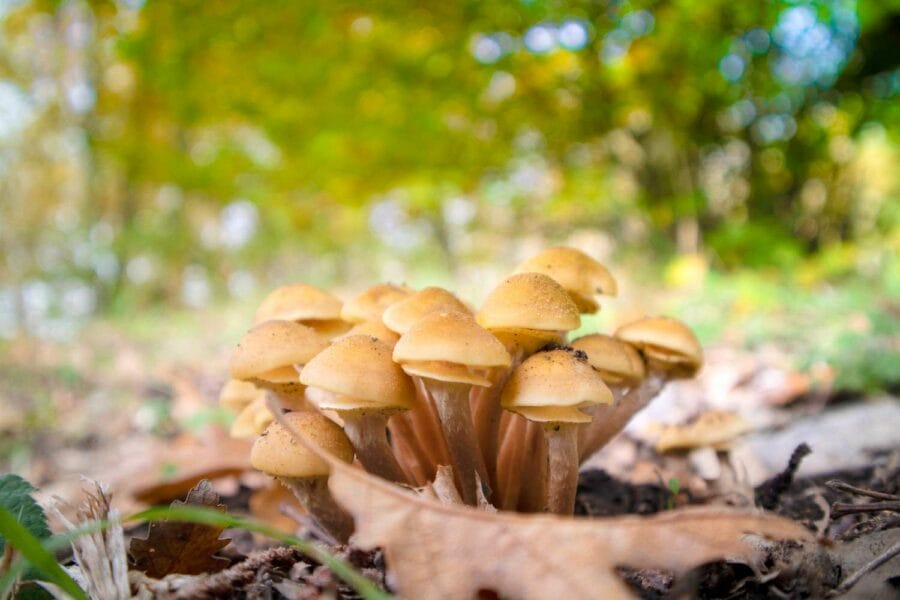Psilocybin, a psychoactive compound found in magic mushrooms, is commonly used for recreational purposes to induce euphoria and hallucinations.
In addition to its mind-altering effects, research has been conducted on the compound’s potential benefits in treating chronic pain.
This article presents a case study on how microdosing mushrooms might assist in mitigating chronic pain.
Key Takeaways:
- Microdosing mushrooms may provide both immediate and sustained pain relief.
- When administered in small doses, psilocybin microdosing generally has fewer side effects compared to traditional pain medications.
- By interacting with serotonin 2A (5-HT2A) receptors, psilocybin can help alleviate pain and other conditions.

The Study
Dr. Matthew Lyes and his team from the Division of Pain Medicine in the Department of Anesthesiology at the University of California, San Diego conducted a study called “Microdosing Psilocybin for Chronic Pain: A Case Series“. They focused on three patients who self-administered low doses of psilocybin to manage their chronic pain symptoms.
Three Patients, One Result – Reduction of Chronic Pain
Patient # 1
| AGE/ GENDER: | 37 Male |
| TYPE OF PAIN: | Neuropathic pain located below a spinal cord injury. |
| PAIN INTENSITY: | Initially 4 to 5/ 10, increasing to 8/ 10 later in the day |
| PSILOCYBIN DOSE: | 250 mg of ground mushroom for less than 6 months |
| OUTCOME: | Discontinuation of prescribed pain medication, decrease in muscle spasms, and improved bowel movement efficiency. No signs of rebound pain or withdrawal symptoms were observed. |
| The patient noted that while his usual medications only managed to lessen the pain, psilocybin effectively eliminated it, reducing his average pain level from 5 to 0. | |
Case Study: Subject #2
| AGE/ GENDER: | 69-year-old Female |
| NATURE OF PAIN: | Complex Regional Pain Syndrome (CRPS) |
| PAIN INTENSITY: | Usually between 5 to 7 on a scale of 10, but it escalates with physical activity and during pain episodes |
| PSILOCYBIN DOSAGE: | 500 mg daily for 7 to 10 days with rest periods (2 to 3 days) over a year. Dosage increases to 750 mg to 1 gram during pain episodes |
| EFFECT: | 80% decrease in pain for 3-4 hours, slowly returning to initial levels after 12 hours. Full pain relief (90%-100%) for 6-8 hours, returning to initial levels after 18 hours. |
| The patient reports a reduced appetite without experiencing nausea. Instances of disorientation or instability in walking are observed when the dosage is increased (750 to 1000mg). | |
Case Study: Subject # 3
| AGE/ GENDER: | 40-year-old Female |
| NATURE OF PAIN: | Lumbar radiculopathy and neuropathic pain |
| PAIN INTENSITY: | 8 on a scale of 10, increasing to full intensity during physical exertion |
| PSILOCYBIN DOSAGE: | 1000 mg from a mushroom chocolate bar every two months. |
| EFFECT: | Significant relief from pain without any psychoactive effects. Increased flexibility and functionality observed. Pain slowly returns to initial levels over 2-4 weeks. Repeated dosing enhances pain management. |
| The patient does not report any significant physical, cognitive, or behavioural side effects. Her mood remains largely stable. She maintains her regular dosage of her SSRI for depression management during the psilocybin treatment period. | |
Comprehending Pain Management with Psilocybin
Continuous signals of somatic and visceral pain strengthen specific neural pathways due to peripheral and central sensitization. This results in a chronic sensation of pain both physically and emotionally. Psychedelics like psilocybin activate 5-HT2A receptors, potentially resetting the brain regions linked with neuropathic conditions.
A patient reported long-term pain relief extending for weeks. This suggests that direct stimulation of the 5-HT2A receptors could lead to central regulation of pain perception and synaptic adaptability.
Potential Side Effects of Psilocybin vs. Traditional Pain Relievers
| PSILOCYBIN (Based on Research Findings) | TRADITIONAL PAIN RELIEVERS |
| Muscle spasms | Nausea |
| Decreased appetite | Abdominal discomfort |
| Confusion | Migraines |
| Unsteady gait | Dependence |
| No mood changes | Drowsiness |
Potential Future Studies on Psilocybin
The research team has identified several potential areas for further study, based on the experiences of three participants, due to their potential benefits.
- Small doses of psilocybin might provide immediate and potentially enduring relief from neuropathic pain, without leading to physical tolerance or addiction.
- Examine the impacts of various treatment approaches used in conjunction with psilocybin. For example, participant #3 experienced an increased analgesic effect when physical therapy was combined with psilocybin.
- Small doses of psilocybin could offer pain relief even without psychotherapy, as demonstrated in this case study. The researchers propose that including therapeutic guidance could potentially enhance or prolong the therapeutic effects.
Study Limitations
Despite the encouraging outcomes in the participants, it’s important to acknowledge the limitations identified in the study.
- The limited sample size may not represent all individuals who experience neuropathic pain.
- The study did not include any participants who did not respond to psilocybin.
- No assessments were conducted before and after treatment to gauge the impact of psilocybin on mental health conditions like depression and anxiety.
- Most of the data was self-reported by the participants.
- The interviewer’s presence and potential biases related to psilocybin could have influenced the participants’ responses.
- The study did not investigate the effect of the placebo effect.
- The study did not measure the quantity of psilocybin in each mushroom.
Microdosing Psilocybin Mushrooms
In the experiment, patients number 1 and 2 consumed a microdose of psilocybin sourced from dried mushrooms in powdered form, whereas patient number 3 combined it with chocolate. There are numerous products available specifically for psilocybin microdosing, and we have put together a short list of some examples below.
Dried Psilocybin Mushrooms
While the particular strain used in the study wasn’t revealed, the following strain is often recommended for beginners.
- Golden Teacher: This is a commonly seen and widely used strain of magic mushrooms.
- Amazonian Cubensis: This strain is known for its beginner-friendly nature and potential cognitive benefits.
- Cambodian: Microdosing with Cambodian cubensis mushrooms can potentially boost focus, improve social awareness, and enhance mood.
Microdosing Capsules
- Euphoria Psychedelics – Micro Calm Capsules: This formulation contains Ashwagandha, Reishi, CBD, Valerian root, and Psilocybin Mushrooms. These ingredients have been scientifically demonstrated to help reduce stress and anxiety.
- Ground Sounds – Microdose Capsules – Champion Lover: This appealing blend offers three dosage levels: 50mg, 100mg, or 250mg of pure psilocybin combined with reishi, cacao, cordyceps, and maca.
- Kind Stranger – Brighten Capsules 250mg: These capsules feature the Golden Teacher strain, renowned for promoting mental clarity, fostering enhanced creativity, and improving focus.
Mitigating Pain with Psilocybin
Despite the research on psilocybin’s potential for pain relief being in its initial phase, anecdotal accounts and small-scale case studies offer promising insights.
These instances underscore the necessity for more rigorous investigation into the potential therapeutic applications of psilocybin, class=”wp-block-list”>
Especially in the realm of managing chronic pain.
Before psilocybin was widely accepted as a means to alleviate pain, hopeful stories from case studies provided relief to those dealing with chronic pain.
Frequently Asked Questions
What effects does microdosing psilocybin produce?
Psilocybin primarily acts on a serotonin receptor known as “5-HT2A” in the prefrontal cortex, leading to two key outcomes:
- Stimulation of “Brain-Derived Neurotrophic Factor” (BDNF)
- Augmented “Glutamate” transmission
Moreover, psychedelics foster connections among brain regions that normally interact less. This unique network is a result of psychedelics’ ability to reduce the activity of the “Default Mode Network” (DMN), which is associated with various cognitive functions such as daydreaming, introspection, and reflecting on the past and future.
What is the most recognized benefit of microdosing mushrooms?
Microdosing may enhance mood, productivity, creativity, and focus. Its most extensively researched benefit is its effect on mental health.
In November 2022, COMPASS Pathways, a mental health company, unveiled the results from their extensive phase 2b trial, a randomized and double-blind study. Their findings indicated that a single dose of psilocybin significantly reduced depressive symptoms compared to a placebo. Participants who were administered a higher dose of 25 milligrams showed a lasting antidepressant response at the twelve-week follow-up.
A study published in the Psychiatry Research Journal suggested that psilocybin is more effective than traditional antidepressant treatments.
How do you determine your dosage?
Start with a 0.1-gram dose of psilocybin mushrooms on the first day. If the expected effects are not observed, you can slowly increase your dose by 0.05 grams on subsequent microdosing days until you find your ideal level.
People with a history of psychotropic drug use may need to increase the dosage to 0.5 grams to achieve the desired effects.
What precautions should be taken before ingesting mushrooms?
class=”wp-block-list”>What is the suggested frequency for taking microdoses of mushrooms?
There exist several well-structured protocols recommending specific microdosing schedules for psychedelics. The primary difference between these protocols lies in the number of “off” days they include, which are the days on which you abstain from microdosing.
The most commonly advised protocols suggest having 1-3 rest days between microdoses. This aligns with the body’s inherent tolerance mechanisms. The three protocols under consideration here are the Fadiman Protocol, the Stamets Stack, and intuitive microdosing.




